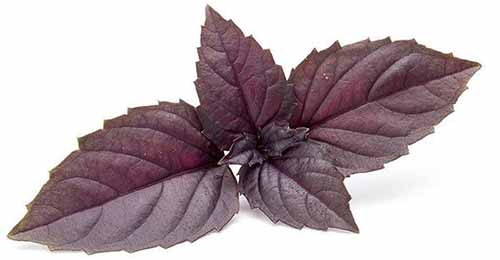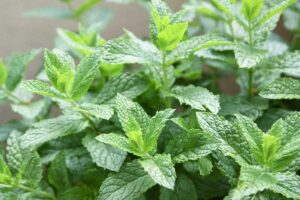Ocimum basilicum ‘Red Rubin’
I can’t help noticing that when an entity is attractive, whether it’s a plant for the garden or something else entirely, it’s often not practical, and the reverse is also true.
But ‘Red Rubin’ basil bucks that trend.
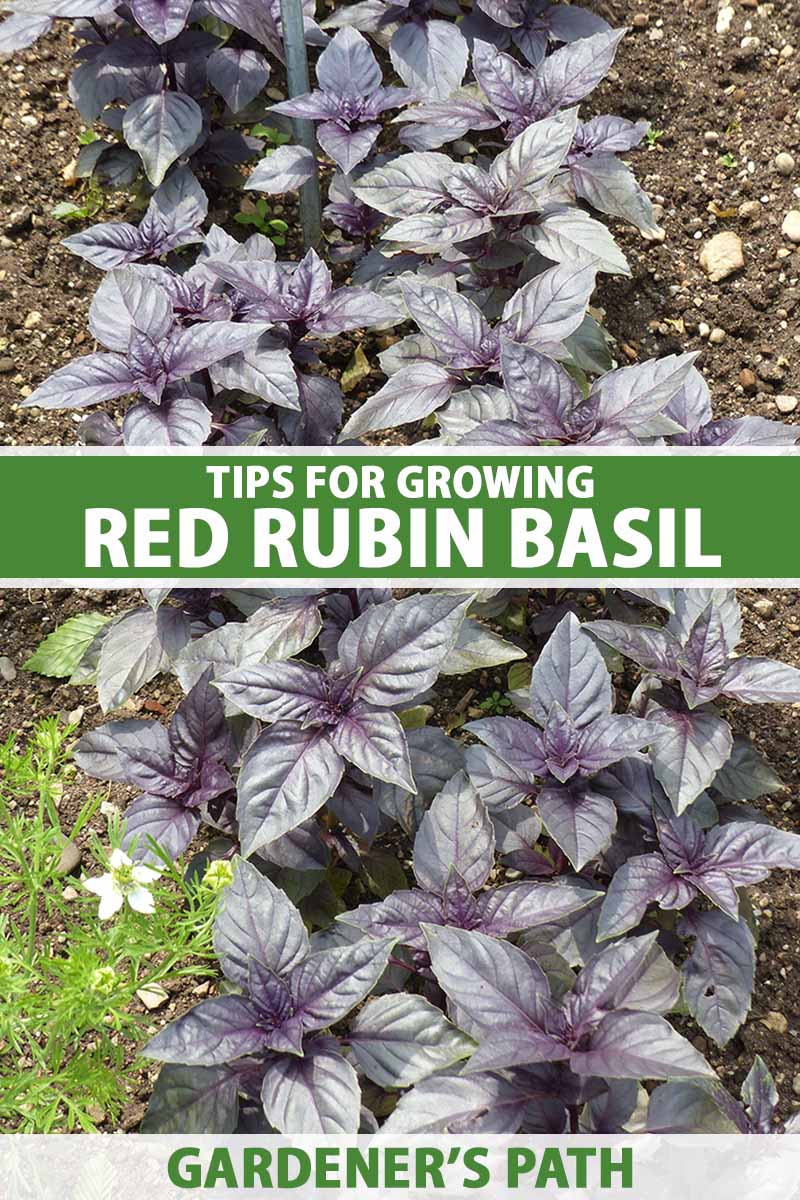
We link to vendors to help you find relevant products. If you buy from one of our links, we may earn a commission.
This Ocimum basilicum cultivar is an appealing shade of reddish-purple that will beautify gardens, borders, containers, and window boxes.
And it also works as a culinary herb, in numerous ways. The leaves and stems can flavor teas, simple syrup for cocktails, vinaigrettes, and baked goods – and replace the typical sweet basils in many recipes.
‘Red Rubin’ tip cuttings and tiny pink flowers make lovely garnishes for cakes and soups, too, while the longer stems add color and scent to bouquets and flower arrangements.
Oh, and this pretty plant is easy to grow – as long as you recognize its need for warm temperatures, full sun, and consistent watering.
Let’s go ahead and take a closer look at this beautiful and practical herb variety. Here’s what I’ll cover:
What You’ll Learn
What Is Red Rubin Basil?
‘Red Rubin’ is a vigorous, large-leaf, sweet cultivar of O. basilicum.
It is distinguished by its bronze-purple leaves that taste of cinnamon and clove. If you don’t pinch the buds off, it will produce stalks of tiny pink flowers.

Often, this variety is classified as O. basilicum var. purpurascens. But other authorities on taxonomy regard the variety purpurascens as a synonym for the species plant that does not require separate classification.
Basil is native to tropical regions ranging from central Africa to Southeast Asia.
In the 1830s, British botanist George Betham was the first to identify the purple basils that came before this cultivar.
These varieties gain their color from anthocyanin compounds, which today are sometimes used to produce red food dye and other natural colorants.
The next leap forward for cultivated purple basil came in the 1950s when botanists at the University of Connecticut bred ‘Dark Opal,’ a cultivar with almost purple-black leaves and a light anise aroma.
Its flavor, ornamental nature, and downy mildew resistance all contributed to All-America Selections honors rewarded in 1962.
‘Red Rubin’ is a “re-selection” of ‘Dark Opal,’ an improved variety of this prized cultivar. Bred in Denmark, it first arrived in North America in 1993.
You may be wondering how the two cultivars are different.
First, ‘Dark Opal’ has almost inky purple leaves, while those on ‘Red Rubin’ are a coppery purple that could be called purple to brick red.
Both types are prone to producing a few leaves that are splashed with green, but this is far more rare in ‘Red Rubin.’
‘Dark Opal’ leaves are smaller, growing about one and a half to three inches long, with crinkled surfaces and slightly ruffled edges. ‘Red Rubin’ leaves are a consistent three inches long once mature and they’re also puckered, but with smooth edges.
While ‘Dark Opal’ leaves arch slightly down from the stems, ‘Red Rubin’ holds its leaves horizontally, making them easier to pick.
‘Red Rubin’ plants grow a bit taller, 18 to 30 inches compared to 16 to 18 for ‘Dark Opal,’ which is part of the reason why its yields are superior to that of other purple basils.
While you may appreciate the prospect of a bumper crop if you’re a cook, prolific ‘Red Rubin’ also produces more leaves, stems, and flowers for bouquets, garnishes, and potpourri – and to attract pollinators and scent the night air.
Sound good? Here’s what you need to know to plant and grow ‘Red Rubin’ in your garden, raised beds, or containers.
Propagation
Along with all that glorious color and scent, ‘Red Rubin’ grows quickly and easily, beginning with its propagation.

If you’re fortunate enough to know someone already growing one sturdy plant or a group of them, you can readily root a stem cutting.
It’s a simple matter of cutting a stem directly beneath its bottom leaf node and then stripping all but the top two sets of leaves.
Set the cutting in a small, clear glass of water and place it in a sunny location.
The stem should sprout roots in three to 10 days, and you can pot the rooted cutting once the roots are at least two inches long.
Continuing on the generous friend theme, it’s also possible to divide mature plants into several new ones. If you have a buddy who would also like to grow ‘Red Rubin,’ you can share one bushy plant by separating it into two.
Our guide to propagating basil has the how-to info you’ll need to root cuttings or divide plants.
Starting basil from seed is another simple, affordable option.
You may need to sow seeds indoors to get a jump on the growing season in some areas, and it’s also possible to grow the plants indoors from start to finish with ample light and warmth.
You can also sow ‘Red Rubin’ for microgreens. This handy microgreen guide will help you get started.
Note that ‘Red Rubin’ is technically a short-lived perennial when grown in USDA Hardiness Zones 10 to 11.
But even in those areas, I recommend sowing fresh seeds each year or rooting new cuttings instead of trying to keep an older plant alive.
This herb grows quickly, maturing in 72 days, and the leaves on young, new plants will be more flavorful. In their second year of growth, basil may become woody and its leaves may have a hot aftertaste or lose flavor altogether.
How to Grow Red Rubin Basil
This basil cultivar may look different from other O. basilicum varieties, but cultivation is essentially the same.
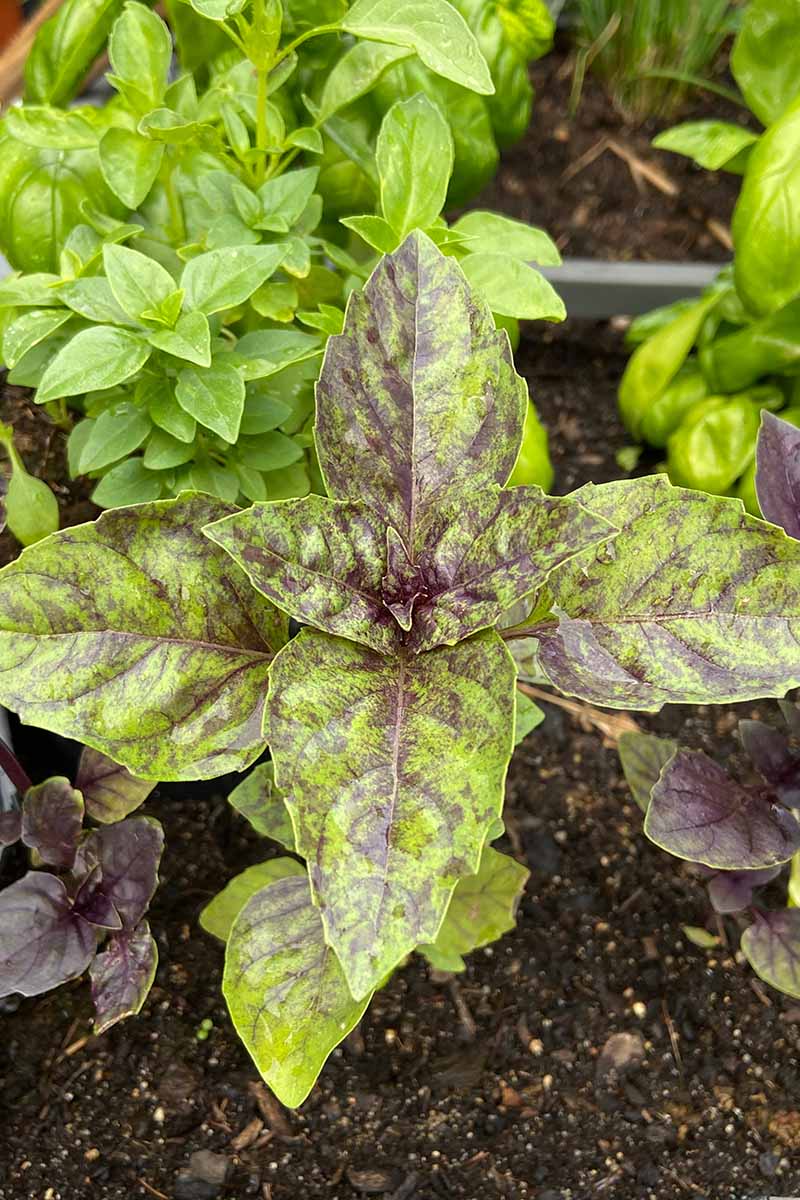
The keys are growing in fertile, well-draining soil, avoiding chilly temperatures, and planting ‘Red Rubin’ where it will receive ample sun.
Remember that all basils are susceptible to frost damage. Not only will the plants die if the temperature dips below about 45°F, they’ll also only put out new leaves when the temperature is consistently at or above 60°F.
If you feel like sudden cold snaps in your area could do your ‘Red Rubin’ in, consider growing at least a couple of plants in containers that you can move indoors to avoid chilly temperatures.
In the garden or planted in permanent outdoor containers, your basil will need at least six hours of sun a day if you’d like the leaves to maintain that rich, coppery purple hue without too many green streaks.
Planting in part shade is a fallback solution, but it’s not ideal – “drab” is not a good look on ‘Red Rubin’ basil. Plants that receive less than six hours of sunlight each day will get leggy, and their leaves will look duller and possibly greener.
Indoors, this purple basil requires a similar amount of direct sunlight or eight or more hours of bright, indirect light. You may need a grow light to supplement if you plan to grow it on a sunny windowsill.
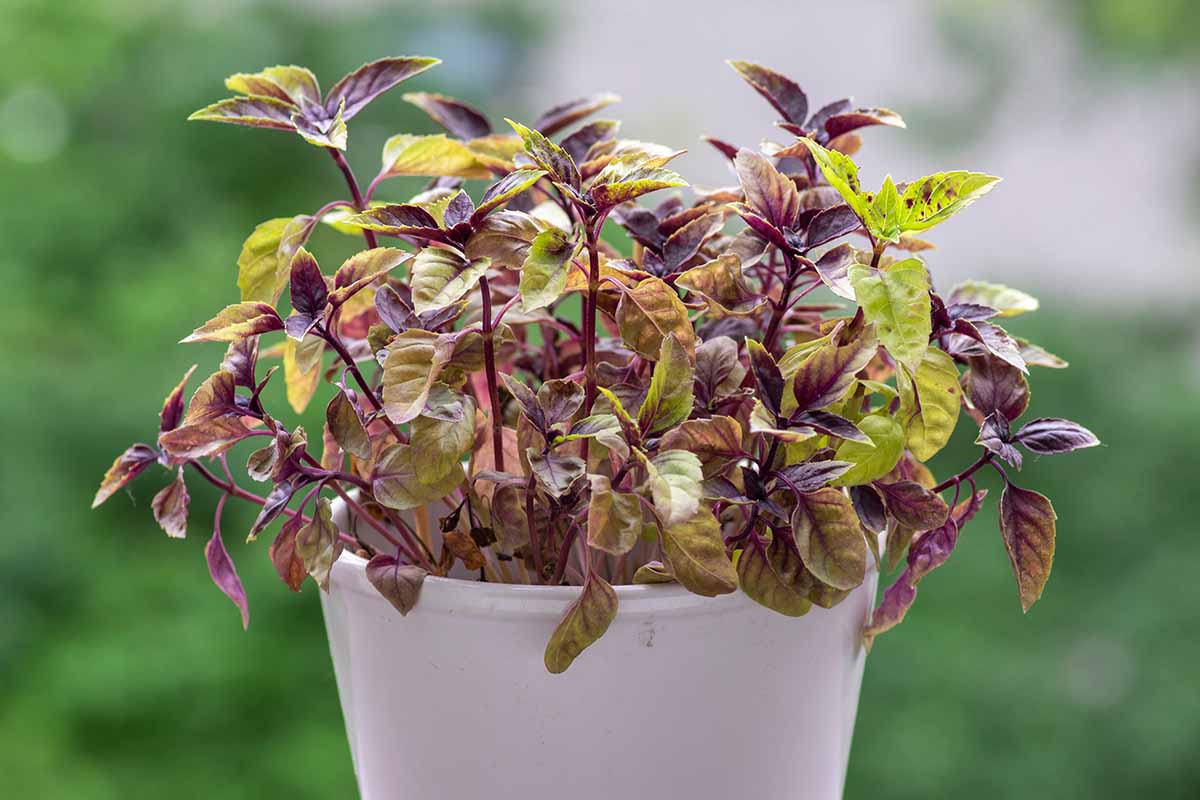
Garden companions should also be given careful consideration when you choose where to grow this beautiful ornamental herb. There are a handful of vegetables, flowers, and other types of herbs that bring out the best in ‘Red Rubin,’ and a few that won’t work at all.
Ever the fan of edible landscaping, I heartily recommend planting this herb along walkways or in borders, especially as a complement to flowers with green stems and color-popping blooms, like zinnias or marigolds.
Both the foliage and the blooms of ‘Red Rubin’ add color to hanging baskets and patio planters. You can also sow or transplant them in a patch of taller annuals like sunflowers.
Remember, though, that basil is a warm-weather-only plant, so resist the temptation to plant it too close to perennials like thyme, or next to annuals that bloom in fall, like sweet alyssum.
You want to be able to uproot basil at the season’s end and get it in the compost without worrying about disturbing other plants’ root systems.
Lots of fellow culinary plants make good companions for ‘Red Rubin’ basil. These include herbs such as cilantro, chamomile, chives, and parsley, and vegetables like peppers, tomatoes, and other nightshades.
I especially like the visual appeal of purple basil next to eggplants, whether they are bearing purple, white, or striated fruits.
Basil will benefit a bean crop by discouraging certain pests, too. Read about the connection in our guide to the best bean companions.
After picking a suitable location and beneficial companions, the work required to maintain thriving basil is minimal. You will want to keep up with watering, a chore you can learn more about in our sweet basil growing guide.
It’s also a good idea to apply a layer of mulch to suppress weeds and retain moisture.
Wait until the plants are at least four inches tall, and then apply a two-inch layer of natural material such as lawn clippings or straw, making sure it hasn’t been treated with pesticides or herbicides.
Don’t let the mulch touch the stems, or this may encourage disease.
‘Red Rubin’ is less prone to powdery mildew than some of its sweet basil relatives, but it can pick up some common basil pests and ailments.
Consult our guides for advice on preventing, detecting, and treating the most common attackers, including aphids, Japanese beetles, slugs and snails, and the fungal infections fusarium wilt and damping off.
Growing Tips
- Plant in well-draining, fertile soil.
- Sow seeds indoors three to four weeks ahead of transplanting outdoors.
- Transplant seedlings outdoors when the temperature is above 60°F.
- Grow in full sun for top yields.
Where to Buy Red Rubin Basil Seed
If you’ve decided to grow ‘Red Rubin,’ prepare for a taste sensation – and a feast for the eyes.
Now, to find some seeds!
Of course, you may find starts for this cultivar at a local nursery or you may be able to root cuttings from a friend’s plant. But I wouldn’t agonize over the search for transplants when seeds are readily available and they germinate so quickly in warm weather.
You’ll have enough leaves to harvest in 30 to 40 days even if you sow from seed.
In your hunt, you may occasionally come across a mislabeled ‘Red Rubin’ packet with a photo of the deep purple ‘Dark Opal’ variety on the front. Keep in mind that ‘Red Rubin’ leaves will look more coppery-purple than that.
You can find conventional ‘Red Rubin’ seeds in packets and in bulk at True Leaf Market.
They also offer an organic option, in 600-seed packets and in bulk, ranging from 4,500 seeds up to a five-pound sack that holds around 1.4 million seeds suitable for mass planting and growing microgreens.
For a more modest quantity, look for 25-seed packets available from Country Creek Acres via Amazon.
You may also find this variety rounding out basil seed collections.
For example, Rebel Gardens sells a seven-packet collection that includes ‘Red Rubin’ in addition to individual envelopes of ‘Genovese,’ lemon, lime, Thai, ‘Spicy Globe,’ cinnamon, and ‘Dark Opal.’ That collection is available via Amazon.
Harvest and Storage
Once this Italian-leaf basil variety has stems at least six inches tall, it’s game on for harvesting.
Picking is a win-win for you and for the plant. When you keep the tips pinched back, you can use the leaves while promoting fuller growth and encouraging plants to produce more leaves to harvest.
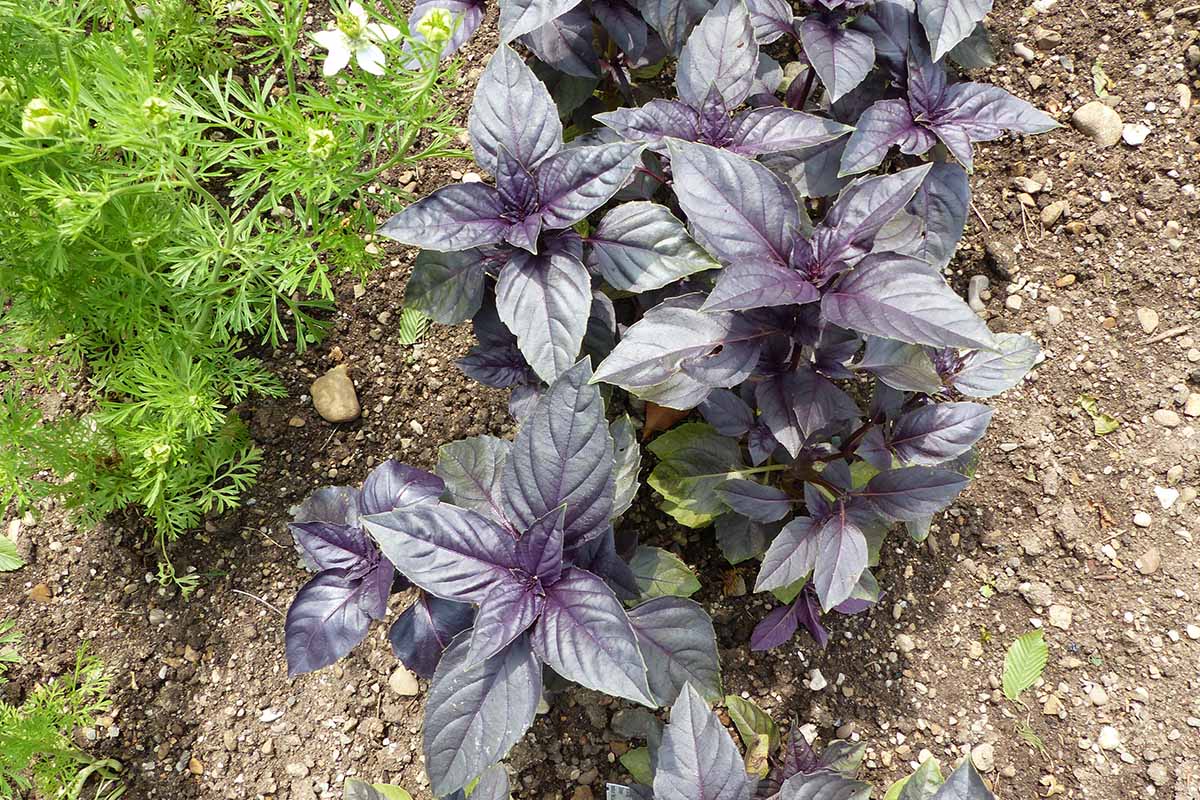
Cut individual leaves from the top or sides, or take sprigs by snipping above a leaf node so the plant will resprout from that spot.
This is the reverse of the process you might use for taking a cutting to root. In that case, you want to remove the lowest node with the stem, so it will sprout roots beneath the water.
To pick stems for bouquets and flower arrangements, let the plants reach at least 10 inches tall and then use scissors to cut the desired lengths. Be sure to strip any leaves from the bottom before placing the stems in water.
Be careful never to pick more than one-third of the foliage at a go or the plant may not be able to rebound.
Of course, it’s always an option to harvest the entire plant, especially towards the end of the season.
I do that by first pulling up the entire plant and then cutting the roots off of the bottom, but you can also slice the entire plant at the crown and till the roots of healthy plants into the bed at the season’s end.
It’s best to pinch any buds that form before they flower. Once the plant blooms the essential oils dissipate, along with the flavor of the leaves.
Always pick the buds and their stalks an inch or two below the part of the stem where they started to form. Otherwise, the plant will form more buds in a matter of days – and it will feel like it happened in the space of an hour!
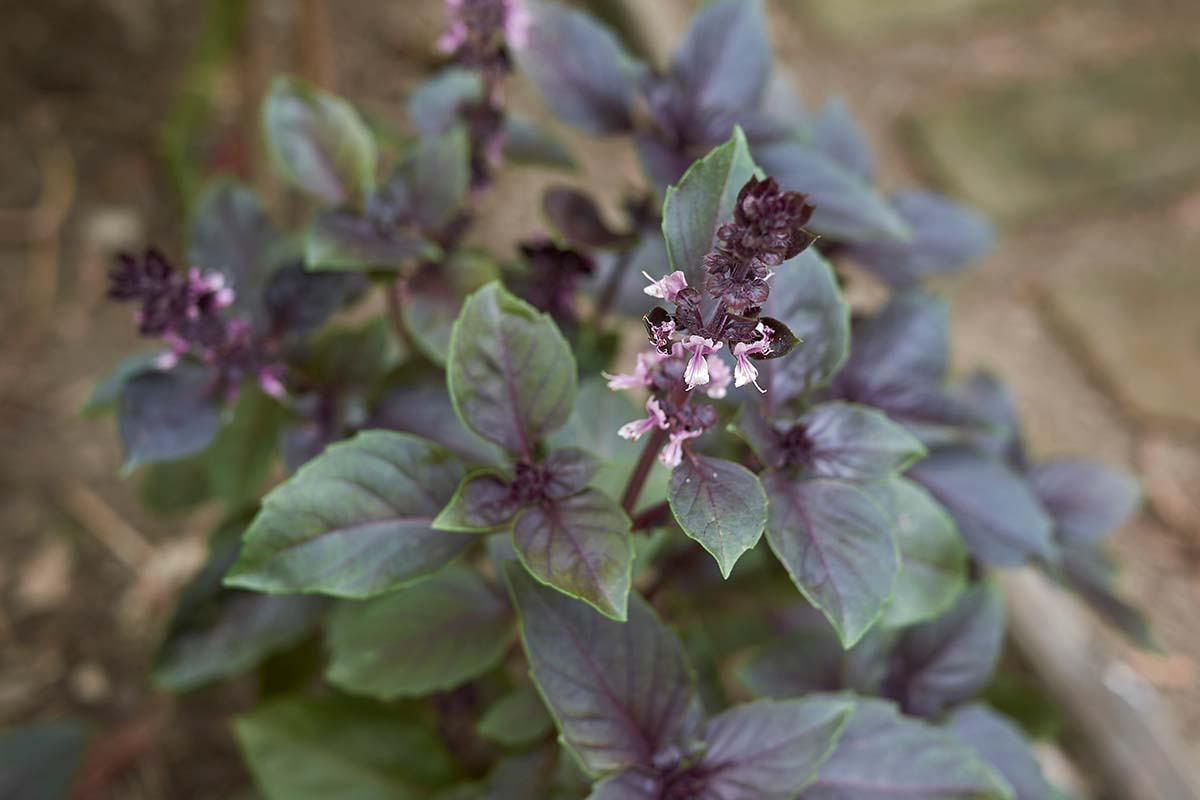
Basil buds and blooms are also edible. You can wash the buds and pluck them from the stems to use them for flavoring, much like you would the leaves. Treat the flowers gently.
For the best flavor and texture, wash and dry the leaves as needed as soon as you harvest them, and use them immediately.
If you like, you can store stems in a glass of water on the counter to use within a couple of days, or promptly put them in water as part of a flower arrangement.
You can also dry ‘Red Rubin’ leaves or flowers for tea or to add to marinades or herb mixes. Follow the directions for drying in our dedicated guide.
When you must pluck but can’t use the fresh herbs right away, to me, the best solution is to mash minced leaves into a compound butter and freeze it for future enjoyment.
You can use ‘Red Rubin’ in place of one or two of the fresh herbs called for in this herb butter recipe from Foodal, our sister site.
You can also freeze some leaves for future use, following the directions in our guide to freezing herbs.
Recipes and Cooking Ideas
There are multitudes of culinary uses for ‘Red Rubin,’ but don’t expect it to replace more typical sweet basil in pesto recipes.
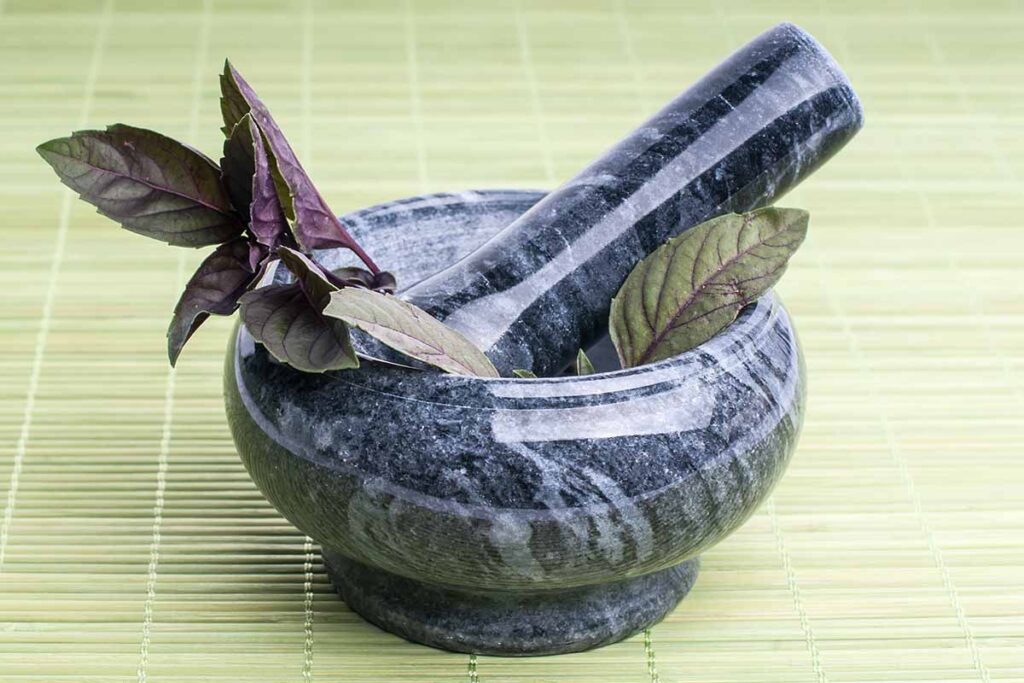
It has more of a baking spice essence and less of the light licorice flavor of other green Italian leaf O. basilicum varieties, with a hint of clove first and foremost. That flavor can overwhelm pesto if you’re used to the milder taste of other basils.
I recommend making a smaller batch using 100 percent ‘Red Rubin’ leaves in place of the sweet leaves, and then use that pesto sparingly for pasta salad and the like.
Or, pair the spicier basil leaves with a milder green, like spinach, in a one-to-three-part ratio. If you add any more, you may find that it has a bitter flavor.
Scaling back the amount you add to pesto will in no way leave you with too much ‘Red Rubin’ on your hands, though!
You’ll want an ample harvest so you can use the fresh leaves in hot tea or dry some to concoct an herbal tea mix for the winter.
You can add baby leaves to spring salad mix, mince large leaves for use in salad dressing, and use the tip cuttings to garnish frosted confections, soups, or cool beverages.
You’ll want to use raw harvested leaves to enjoy that dashing reddish-purple coloring.
They’ll turn a greenish-brown when they meet heat, which isn’t nearly as pretty but will still taste fine. Just make sure to add them at the end of cooking so they’ll retain their flavor.
The leaves make a tasty addition to marinades and casseroles. Try a couple of tablespoons chopped in this marinade that’s part of a delicious lemon chicken quinoa bowl recipe from our sister site, Foodal.
Or, use them in place of other sweet basils to pep up frozen treats like this vegan vanilla bean ice cream recipe from Foodal, or as a flavor accent in fruit-infused water.
Speaking of ‘Red Rubin’ and drinks, don’t overlook the adult beverage category. The color will pop when you muddle the leaves to add to mojitos or garnishes. Just remember that you’ll lose that reddish-purple hue if you add it to flavor hot simple syrup.
Quick Reference Growing Guide
| Plant Type: | Herbaceous annual or short-lived perennial herb | Tolerance: | Moist soil, part sun |
| Native to: | Tropical regions in Africa, Southeast Asia | Water Needs: | Moderate |
| Hardiness (USDA Zone): | 4-9 (annual), 10-11 (perennial) | Maintenance: | Low |
| Season: | Summer | Soil Type: | Organically rich loam |
| Exposure: | Full sun | Soil pH: | 6.0-7.5 |
| Time to Maturity: | 72 days | Soil Drainage: | Well-draining |
| Spacing: | 8-10 inches | Companion Planting: | Borage, chives, eggplant, lettuce, marigolds, okra, oregano, parsley, lettuce, tomatoes |
| Planting Depth: | 1/4 inch (seeds), same depth as container (transplants) | Avoid Planting With: | Cucumbers, fennel, lavender, mint, rosemary, sage, thyme, shorter annuals that need full sun |
| Height: | 18-24 inches | Family: | Lamiaceae |
| Spread: | 12-18 inches | Genus: | Ocimum |
| Growth Rate: | Fast | Species: | Basilicum |
| Common Pests and Disease: | Aphids, Japanese beetles, spider mites, slugs and snails, whiteflies; bacterial wilt, downy mildew, fusarium wilt, gray mold, leaf spot, root rot | Cultivar: | Red Rubin |
My Love Is Like a Red, Red Rubin
I have this habit of strolling through the garden picking a bud here, a stem there, and carrying these herbaceous bits with me until I empty my pockets in the evening.
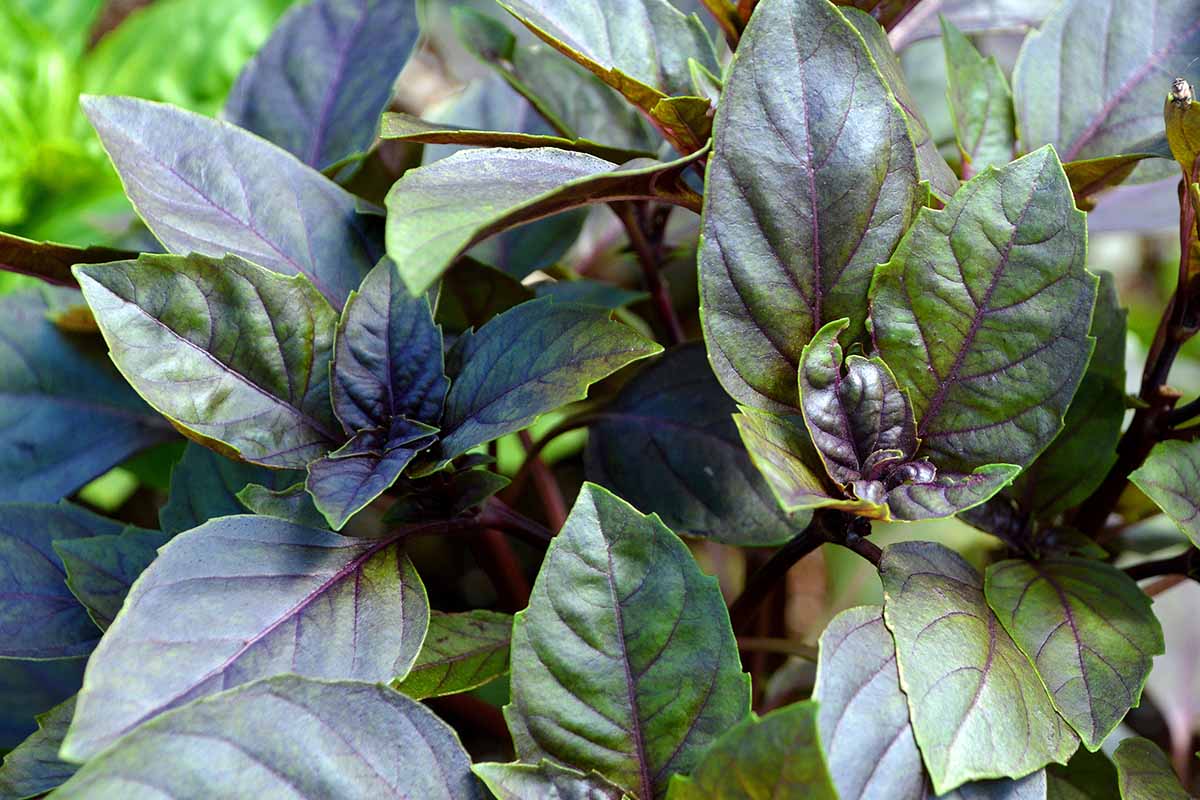
Right now it’s winter as I’m writing this, but there’s a dried bit of ‘Red Rubin’ from last summer on the dresser tray where I keep loose change.
It’s still a lovely, dark red and has a faint cinnamon-anise scent. I love the aroma and the reminder of seasons past.
Do you have a fond memory that involves this ruby-colored basil? Growing tips or questions to share? The comments section below awaits your input.
And if you found this information helpful, read these basil guides for more practical tips and inspiration:
